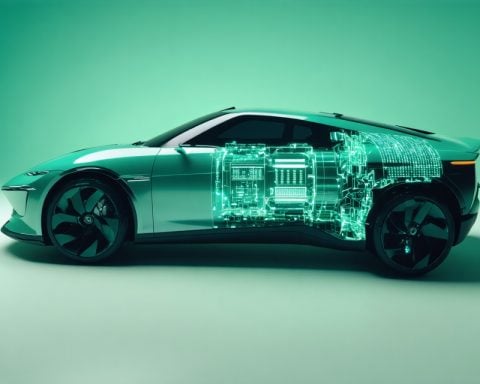- South Korea mandates safety certification for all electric vehicle (EV) batteries, providing each with a unique identification number.
- EV batteries will undergo safety inspections every three years to enhance consumer protection and management.
- The safety overhaul aims to prevent incidents like the recent EV blaze in Incheon, which highlighted the need for stringent safety measures.
- New school buildings in South Korea must include advanced, seismic-resistant firefighting systems to ensure increased safety standards.
- This dual-focus initiative underscores South Korea’s commitment to enhancing safety across technological and educational sectors.
- The nation strives to safeguard its progress in electric innovation and educational infrastructure with robust legal safety updates.
Electric vehicles in South Korea are getting a safety overhaul. Imagine this scene: sleek EVs cruising silently down the streets, each carrying a sense of assurance. As of February 17, the government mandates that automakers certify the safety of all EV batteries, with each unit receiving a distinctive identification number. This measure ensures that these batteries, vital to our eco-conscious journey, are carefully tracked from birth to retirement.
But it’s not just a matter of stamping a seal of approval. These batteries will face the scrutiny of additional safety inspections every three years. The goal? Fortify the safety management of electric vehicles, shielding consumers and their investments from the fiery disasters of the past.
Recall the chilling image of a smoldering parking lot in Incheon, where an electric car blaze recently ravaged nearly 1,000 vehicles. Such incidents underscore the urgent need for robust safety measures, which this new system aims to address.
Meanwhile, a different kind of safety net is spreading across South Korea’s educational landscape. From the very foundation, new school buildings—whether they’re grand universities or cozy kindergartens—must now be equipped with state-of-the-art firefighting systems. And it’s not just any installation; these systems will meet seismic-resistant standards, ready to battle flames even when the earth trembles.
This dual-focus approach, targeting both technological and educational environments, signals South Korea’s commitment to safety. As the nation strides into a future studded with electric innovation and bustling campuses, these legal updates ensure that fires of the past will not light the way forward. The message is clear: safety, tracked and monitored, is the silent guardian of progress.
New Era of Electric Vehicle Safety: How South Korea is Pioneering Innovations
How-To Steps & Life Hacks: Enhancing EV Safety
To ensure the safety of your electric vehicle (EV) in light of South Korea’s new regulations, here are some life hacks and steps you can take:
1. Routine Battery Checkups: Take advantage of the mandated safety inspections every three years by scheduling regular checks with certified professionals to detect issues early.
2. Vehicle Monitoring Apps: Utilize mobile apps that provide real-time data on your car’s battery health and performance, keeping you informed of any anomalies.
3. Stay Updated with Software: Ensure your vehicle’s software is updated frequently. Automakers often release patches that can improve safety features.
4. Insurance Considerations: Check with your insurance provider to see if newly installed or certified batteries qualify you for discounts or improved coverage.
Real-World Use Cases: Implementing Safety Innovations
Electric vehicles, having gained traction for their environmental benefits, now incorporate robust safety standards:
– Fleet Management: Companies using EVs for logistics and transport can implement tracking systems that align with battery ID regulations, ensuring regular maintenance.
– Public Transport: Municipalities can enhance public trust in electric buses by showcasing adherence to safety certifications and inspections.
Market Forecasts & Industry Trends: EV Surge in South Korea
The move to bolster battery safety might catalyze the growth of the EV market in South Korea:
– Increased Consumer Confidence: By addressing past fire incidents, the new measures could lead to a surge in EV adoption.
– Technological Investment: Expect greater investments in battery tech, focusing on longer life spans and improved safety.
According to BloombergNEF, the global EV market is expected to reach $2.5 trillion by 2030, with South Korea likely playing a notable role due to its tech advancements and regulations.
Reviews & Comparisons: Safety Systems and Features
Comparing safety features across brands:
– Hyundai vs. Kia: Both companies are pushing battery innovations. Hyundai focuses on integrating advanced cooling systems, while Kia explores novel battery compositions.
– Tesla Impact: Tesla’s enhanced thermal management will set a benchmark others may follow, driving improvements in battery safety.
Controversies & Limitations: Navigating the Concerns
Despite the benefits, there are controversies and limitations to consider:
– Cost Implications: Stricter safety standards could mean higher initial costs for consumers, though long-term savings from enhanced safety are expected.
– Technology Adaptation: Smaller automakers may struggle with the swift implementation of these changes, potentially impacting market competition.
Features, Specs & Pricing: Understanding the Tech
The mandated identification numbers will aid in:
– Traceability: Understanding any failures by tracking production and performance charts.
– Seismic-Standard Fire Systems: Especially in schools, showcasing South Korea’s emphasis on both innovation and safety.
Security & Sustainability: A Holistic Approach
Safety measures dovetail with sustainability goals:
– Recyclable Batteries: The continuous monitoring of batteries ensures not only safety but facilitates the recycling process, aligning with circular economy principles.
– Renewable Energy: Encouragement of using renewable sources to charge EVs, further reducing environmental impact.
Insights & Predictions: Future Outlook
Looking forward:
– Next-Gen Batteries: Research will likely focus on solid-state batteries offering better safety profiles.
– Infrastructure Expansion: Growth in EV charging infrastructures will be urgent to meet increased demand and safety checks.
Tutorials & Compatibility: Leveraging New Systems
Manufacturers will likely release tutorials on:
– Battery Maintenance: Promoting best practices to extend lifespan and improve safety.
– Integration: How existing EVs can be retrofitted to comply with new safety standards.
Pros & Cons Overview: Quick Takeaways
Pros:
– Enhanced Safety: Regular checks mitigate the risk of battery fires.
– Increased Trust: Consumers feel reassured by stringent regulations.
– Long-Term Value: Potential reduction in insurance costs due to improved safety.
Cons:
– Higher Costs: Initial expense for compliance might deter new EV buyers.
– Implementation Challenges: Some automakers may face difficulties adapting swiftly.
Actionable Recommendations
For consumers and industries alike, the key tips are:
– Stay Informed: Regularly check for updates on safety features.
– Engage with Manufacturers: Provide feedback on safety features to catalyze improvements.
– Leverage Government Initiatives: Use incentives provided for EVs to offset costs while ensuring safety compliance.
By following these steps, individuals and companies can not only adhere to safety regulations but also enjoy a more robust, efficient, and secure EV experience.
For more on EVs and industry trends, visit Hyundai and Kia.
















